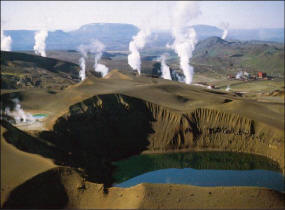|
CULTURE
Visitors to Iceland are always surprised by the tremendous vitality of
its cultural life. Lovers of the arts and culture are in for a real
treat in Reykjavik. Strong Icelandic tradition and international culture
thrive side by side to weave a rich tapestry of delights and
experiences. On the cultural front there is the choice of symphony
orchestra, opera, theaters (there's no language barrier for the frequent
musicals), and a colorful variety of other musical events. Alongside
home artists, growing numbers of celebrated international performers
from all genres are eager to include "cool but hot" Iceland in their
tour programs these days. And for a little daytime cultural input, a
fine national and international mix is also found at the many visual art
museums and galleries.
|
 |
|
Visual Art
Reykjavik and the surrounding area are home to a vast number of art
galleries of every size, shape and description. Some are architectural
delights, some intimate and cozy; some of them even double as cafes or
movie-theater lobbies. And none of them ever stands empty. In fact the
output of fine arts and crafts in Iceland far surpasses what the
existing galleries and showrooms can handle.
Reykjavik
Art Museum
comprises the Asmundur Sveinsson Sculpture Museum, the Kjarval
Collection, the Erro Collection, the Architectural Museum and the
Reykjavik Art Collection. The Museum is located in three different
places in Reykjavik, each with its own characteristics.
Harbor House: A better location for an art museum than the Harbor
House is difficult to imagine. The panoramic view from the large windows
in the cafeteria and library, facing north, features the old harbor. On
the South side, there is the hustle and bustle of busy downtown,
allowing visitors to capture city-life and passers-by to catch a glimpse
of the best of Icelandic art. Opened in April 2000, the museum has six
exhibition halls for art, a multi-purpose space and an outdoor area in
an enclosed courtyard. It hosts exhibitions from the general collections
of the Reykjavik Museum and diverse temporary exhibitions of works by
Icelandic and international artists. Exhibitions from the Erro
Collection also have a permanent place in the museum's schedule.
The
Asmundur Sveinsson
Sculpture Museum:
The museum is dedicated to the sculptures and drawings of artist
Asmundur Sveinsson (1893-1982). The collection is in the artist's former
studio and home, which he designed mostly himself. A sculpture garden
surrounds the museum adorned by almost thirty of his sculptures.
Kjarvalsstadir: At Kjarvalsstadir works by leading Icelandic and
international artists of the 20th century are exhibited. The works of
Johannes S. Kjarval, "Iceland's best-loved landscape painter" are
regularly on display. A museum shop and cafeteria, overlooking the
Miklatun Park and the Pearl, are also situated at Kjarvalsstadir.
The National Gallery, founded in 1884, houses the national
collection of 19th and 20th century Icelandic and international art. The
National Gallery is also a center for the study, documentation and
promotion of Icelandic art. The National Gallery of Iceland regularly
exhibits a variety of works from its own collection, as well as
extensive special exhibitions of works by Icelandic and international
artists every year.
Asgrimur Jonsson (1876 - 1958) bequest all of his paintings to
the Icelandic nation and they now form a department for the National
Gallery, housed in a separate premises at the artist's former studio on
74 Bergstadastraeti. The collection contains oil paintings, watercolors
and drawings.
The Arni Magnusson Institute, located on the University Campus,
is a short walk from the old center of Reykjavik. It is a research
institute exhibiting medieval and later Icelandic manuscripts.
The Einar Jonsson Museum, opposite the Hallgrimur Petursson
Memorial Church, is an indoor and outdoor sculpture exhibition.
The Arbaer Open Air Museum is one that all people interested in
Icelandic society past and present should visit. It is a museum of
living history, meaning the staff dress in period clothing and attempts
are made to re-create the past as accurately as possible. The name of
the museum is drawn from the old turf farm Arbaer, located on the
premises. The Arbaer Church, which is also a turf building, dates back
to 1842. Its interior is quite lovely in its Nordic austerity. The
village is a collection of houses - including a quaint little general
store - which mirror the living style of 20th century Reykjavik, from
ordinary working people through to the higher echelons of society. In
between the houses are generous stretches of lawn, well suited for
playing games, lounging or even soaking up the sun in good weather.
Theater
The Icelandic theater scene, which runs year-round, couldn't be hotter
these days with more shows currently running than ever before. Reykjavik
has two full-time companies performing at the National Theater and the
Reykjavik City Theater.
Symphony
Iceland's cultural season begins in the fall with the first concert by
the Icelandic Symphony Orchestra. Concerts, performed at the University
Concert Hall, have received rave reviews from critics at home and
abroad. Foreign conductors and featured artists have performed alongside
Icelandic musicians playing works by Icelandic and foreign composers.
Opera
The Icelandic Opera opens its cultural season in the fall with
performances at the northernmost opera house in the world. Although the
elegant old cinema house in the heart of Reykjavik seats only 473,
individual productions have drawn overall audiences of 8,000.
|

